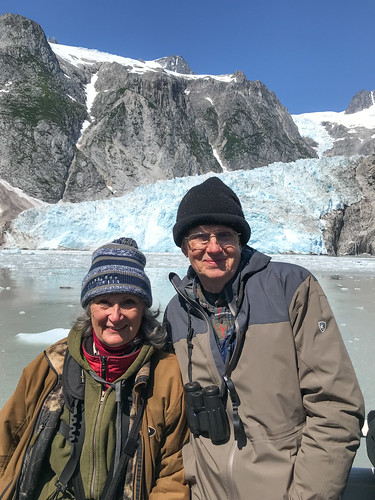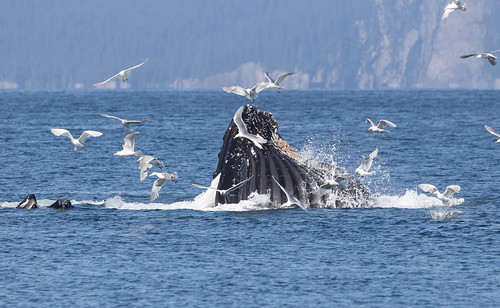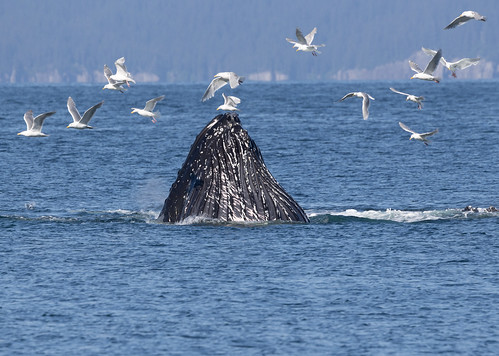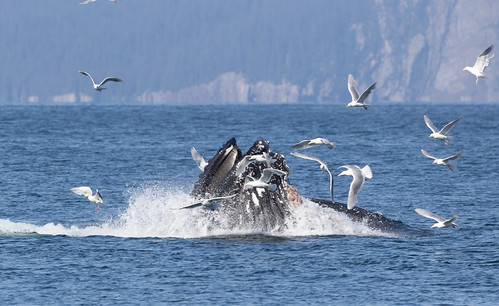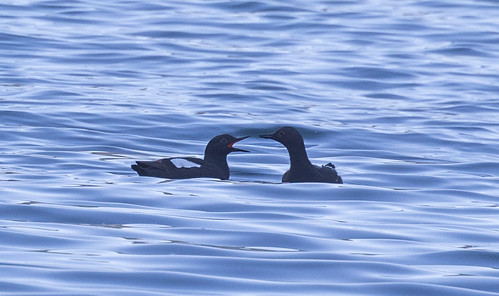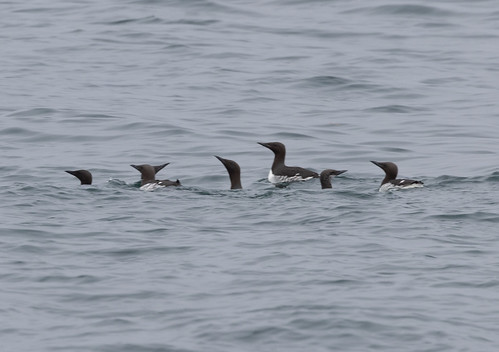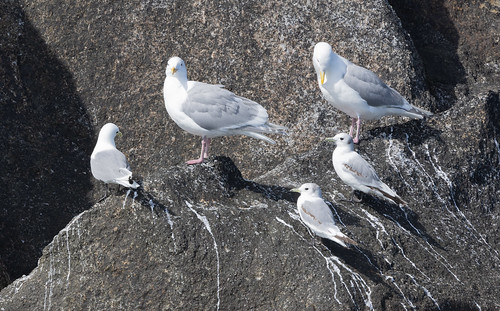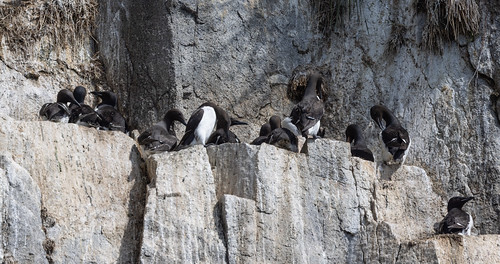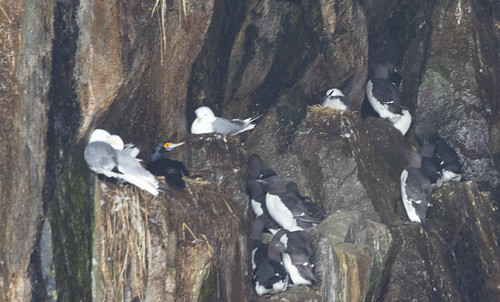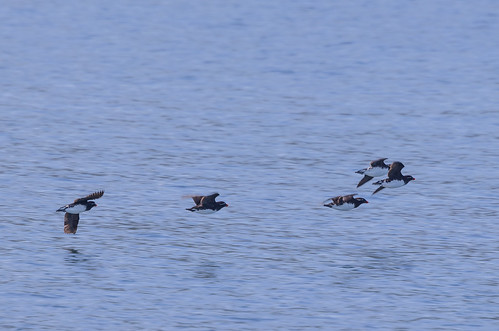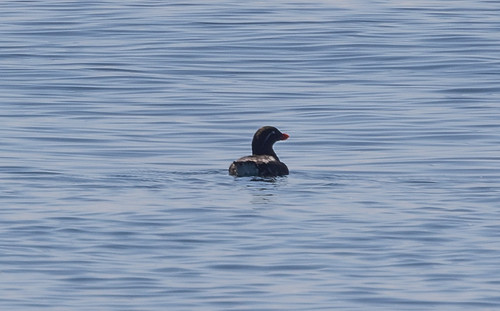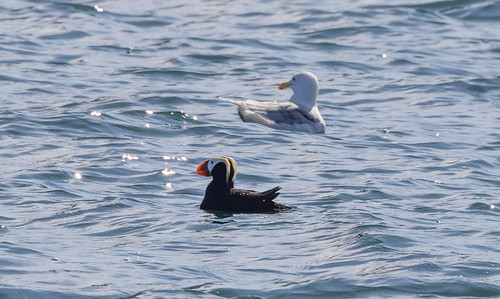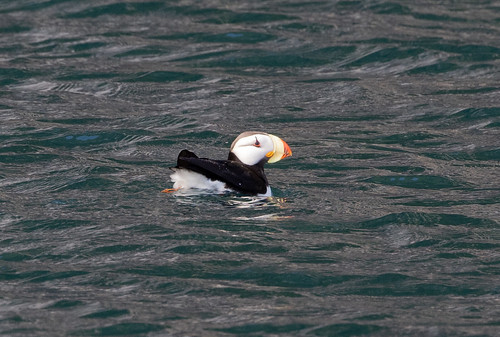At the end of a delicious and satisfying meal, what is tastier than dessert? The more filling and satisfying the meal, the smaller the dessert can be and still be perfect. Two weeks in Alaska was pretty darn satisfying, so I’d have been perfectly content with a sweet but light final day of birding, but somehow our last full day turned out to be the sweetest, richest, best dessert possible.
Our group was signed up for an all-day boat trip into Kenai Fjords National Park and the Alaska Maritimes National Wildlife Refuge on June 22. We took the 9-hour trip aboard the Orca Song that goes all the way through the narrow Northwestern Fjord to the Northwestern Glacier (starred on the map).
On the boat trip, I added the only lifer I could have reasonably expected to see after our Nome adventure, met my goal of getting halfway decent photos of both species of Western puffins, and had the most splendid experiences with whales and orcas I’d ever imagined.
This day and the day we went up the Kougarok Road out of Nome to see the Bristle-thighed Curlew were the two days of the entire tour when we had to prepare for worst-case scenarios. Our hike up the dome for the curlew is usually long and arduous, involving negotiating a mile or more of trudging through tundra tussocks once we reach the top of the muddy dome, so we had to wear sturdy boots with ankle support and be physically prepared for what I was calling a “death march.” And on this boat trip, we’d be facing the coldest conditions of the entire two weeks, with no protection from wind and potentially a lot of wave action. Our leaders would be staying at the bow for the entire day, and strongly advised us to stay up there with them unless we needed to warm up or go inside the cabin to eat or drink. We were warned to take something for seasickness if that could be a problem, and also that waves usually wash onto the deck, making it slippery as well as unsteady. Much of my focus while preparing for this trip was on selecting appropriate clothing for this one day.
But oddly enough, just like that curlew “death march,” the anticipation of rugged conditions on this boat trip far exceeded the actual event. When we left the port in Seward, the sky was clear, there was no wind, and the water was shockingly still. Improbably, it stayed like that the entire day! I know that professional guides tend to make every experience sound like one of the best the guide has ever experienced—I’ve seen this often enough to use my own judgment about how rare or exciting anything on a guided tour is—but such cooperative conditions every inch of the way really were unusual.
As with the Denali National Park bus tour, almost every participant except those in our group was there for glaciers, spectacular scenery, and mammals, not birds. Our guides made sure that the captain and naturalist knew which birds we wanted to see, and they brought us to a few wonderful seabird nesting cliffs and pointed out good birds wherever possible, so we had superb birding in addition to getting to see all those glaciers, spectacular scenery, and mammals, which were thrilling even for a monomaniacal birder like me.
In order to be sure that all of us would get places on the bow, we arrived at the harbor nice and early to be at the head of the boarding line. The wait was pleasant, and once we got going, we were barely out an hour before we came upon humpback whales “bubble-net feeding.”
Humpback whales don’t eat during the half of the year that they’re breeding and giving birth in warm tropical and subtropical waters—they live off their fat reserves. That means that while they’re in their cold feeding waters the other half of the year, they must make up for lost time. Humpbacks are one of the few whales that engage in surface-feeding behaviors, and are especially famous for this bubble-net feeding. One whale exhales out its blowhole at a gathering of prey. Then other whales join in, blowing bubbles as they circle the prey, forming a circular “bubble net” which can be 10 to 100 feet in diameter. Then one whale makes a feeding sound and all the whales simultaneously swim up with their mouths open.
Their mouths may be huge, but their throat is tiny—just grapefruit size—and humpback whales have baleen, not teeth, so they cannot rip large fish into manageable bits. So they focus on krill and small schooling fish such as herring and juvenile salmon. They have long throat grooves from the top of their chin all the way down to the navel, allowing the mouth to expand to take in as many trapped fish as possible along with up to 15,000 gallons of sea water, which will stream out through the baleen as the fish go down the hatch. Bubble-net feeding works—humpback whales manage to take in from 2 to 2 ½ tons of food every day. It was thrilling to witness this for the first time in my life.
As compelling as the whales are, a lot of birders on boat trips get sick of watching them instead of birds. Fortunately, our group seemed happy to stay put watching these wondrous mammals performing this fascinating behavior, and even if they weren’t happy whale-watching, dozens of Glaucous-winged Gulls were swimming nearby and flying just above the whales, hoping to capitalize on so much prey at the surface. Lots of other seabirds, such as Pigeon Guillemots...
...Common Murres...
...and both puffins were milling about.
Vessels are prohibited from approaching close to whales, and also from staying within whale-watching distance beyond a strict time limit, so eventually we moved on. We spent part of the time gliding past the steep cliffs rising above the narrow paths of water that define fjords. Those cliffs are about as inaccessible to mammalian predators as can be, which is exactly why so many seabirds nest on them. I was thrilled to get to photographs of nesting Glaucous-winged Gulls and Black-legged Kittiwakes…
…and Common and Thick-billed Murres.
We saw plenty of Pelagic Cormorants.
I even got a glimpse, and a poor photo, of a Red-faced Cormorant on the nest with murres and kittiwakes.
We missed Kittliz’s Murrelet, a seabird I’d have loved to see though it wouldn’t have been a lifer. But I got fine looks and even photos at the one seabird I most desperately wanted to see and photograph—my lifer Parakeet Auklet.
I’d been hoping against hope to get halfway decent photos of Tufted and Horned Puffins. This trip exceeded my hopes, giving me nice photos of both species in the water…
…and on the nesting cliffs.
The splendid birding was matched, and perhaps even surpassed, by gorgeous scenery, thrillingly noisy calving glaciers, and mammals. Harbor seals swam in the water and rested on chunks of ice.
Steller’s sea lions lounged about on rocky shores.
Sea otters are too shy to pose for tourists but I did grab a couple of grainy distant photos.
We also saw mountain goats on one rocky cliff.
Right after we’d watched a huge glacier calving event, one of the crew members pulled a big chunk of that glacier ice out of the water, which they used to prepare delicious margaritas.
Naturally I had one, which may have contributed an extra glow of appreciation when a pod of orcas showed up and gave me some of my favorite photos of the entire Alaskan adventure.
That night at our celebratory dinner, I had a lovely blueberry mojito. This was the only day of the entire tour that I had even one drink, and that second one perhaps is why I was too tired to sit around the restaurant waiting for dessert, so Russ and I headed back to the hotel before the rest of the group. They all got great looks at six northern river otters playing on the dock right outside the window. I’m not sure the most delicious cocktail in the world was worth the price of missing that, but I wasn’t bummed out when I heard—nothing short of missing a high-resolution video of a family of Ivory-billed Woodpeckers could have cast even a tiny shadow over my memories of a perfect day.
